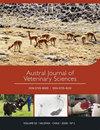加载香芹酚的侵袭体对耐多药的肠杆菌科分离菌和家蝇的疗效
IF 0.8
4区 农林科学
Q3 VETERINARY SCIENCES
引用次数: 0
摘要
本研究旨在评估装载香芹酚的内吸体(CLI)对耐多药(MDR)肠杆菌科细菌及其机械载体家蝇的抗菌活性。CLI是在实验室中制备和表征的。大肠埃希菌、铜绿假单胞菌、肠炎沙门氏菌亚种、伤寒沙门氏菌亚种和氧合克雷伯氏菌是被调查的 MDR 肠杆菌科菌株。这些菌株最初是从自然感染的鸡中分离和鉴定出来的。采用扩散法评估了 CLI 对 MDR 分离菌的抗菌活性。此外,还测试了 CLI 对家蝇幼虫和蛹的杀虫活性。所有被评估的分离物的 MDR 指数都大于 20%,表明它们都具有多重耐药性。在 0.0125% 的剂量下,CLI 可降低除鼠伤寒杆菌和铜绿假单胞菌以外的所有分离菌的生长速度;然而,纯香芹醇仅能抑制氧合克雷伯氏菌的生长。此外,在不同浓度下,CLI 和纯香芹酚都能抑制氧杂克雷伯氏菌的生长。CLI 抑制大肠杆菌和肠炎球菌的浓度低于纯香芹酚,即使浓度加倍也是如此。即使在低浓度下,香芹酚和 CLI 也会导致幼虫大量死亡,半数致死浓度分别为 2.54 和 2.19 µl/ml。此外,在 3.125 µl/ml 的低浓度下,这两种物质对蛹都有很高的抑制率(PIR)。总之,CLI 具有很强的抗菌作用,尤其是对 MDR 分离物,同时还对家蝇具有杀虫活性。本文章由计算机程序翻译,如有差异,请以英文原文为准。
Carvacrol-loaded invasomes efficacy against multidrug resistant isolates of Enterobacteriaceae and housefly
The current study aimed to evaluate the antimicrobial activity of carvacrol-loaded invasomes (CLI) against multidrug-resistant (MDR) Enterobacteriaceae and its mechanical vector, the housefly. CLI were prepared and characterized in the laboratory. Escherichia coli, Pseudomonas aeruginosa, Salmonella enterica subsp. enterica serovar Enteritidis, Salmonella enterica subsp. enterica serovar Typhimurium, and Klebsiella oxytoca were among the MDR enterobacteriaceae stains investigated. These strains were first isolated and identified from naturally infected chickens. The antibacterial activity of CLI against the MDR isolates was evaluated using the diffusion method. In addition, the insecticidal activity of CLI against housefly larvae and pupae was tested. The MDR index of all evaluated isolates was greater than 20%, indicating that they were all multidrug-resistant. CLI decreased the growth of all isolates except S. Typhimurium and P. aeruginosa at a dose of 0.0125%; however, pure carvacrol inhibited the growth of only Klebsiella oxytoca. Furthermore, both CLI and pure carvacrol inhibited Klebsiella oxytoca growth at different concentrations. CLI inhibited E. coli and S. enteritidis at lower concentrations than pure carvacrol, even at a doubled concentration. Carvacrol and CLI caused significant larval mortality even at low concentrations, with LC50 reached at concentartions of 2.54 and 2.19 µl/ml, respectively. Furthermore, at a low concentration of 3.125 µl/ml, both elicited a high percentage inhibition rate (PIR) in pupae. In conclusion, CLI demonstrated substantial antibacterial action, particularly against MDR isolates, as well as pesticide activity against houseflies.
求助全文
通过发布文献求助,成功后即可免费获取论文全文。
去求助
来源期刊

Austral Journal of Veterinary Sciences
Veterinary-General Veterinary
CiteScore
1.60
自引率
0.00%
发文量
18
期刊介绍:
Austral Journal of Veterinary Sciences (formerly Archivos de Medicina Veterinaria) publishes original scientific contributions in English, containing the latest developments and discoveries in veterinary sciences. The journal covers topics such as animal health and production, preventive medicine, zoonosis, pharmacology and therapeutics, methods of diagnosis, and other areas related to the veterinary field.
Austral Journal of Veterinary Sciences aims to divulge information about advances in veterinary medicine among universities, research centres, industries, government agencies, biologists, agronomists and veterinarians.
 求助内容:
求助内容: 应助结果提醒方式:
应助结果提醒方式:


